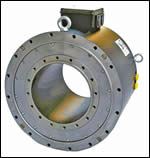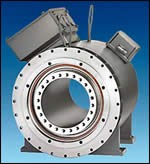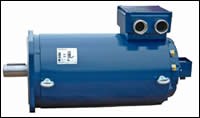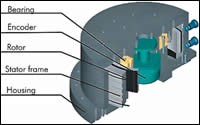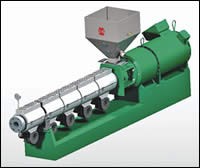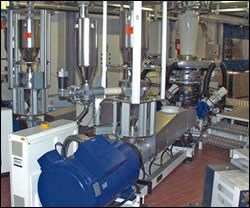Shhh ... Can You Hear the New Extruder Motors?
Silent, space-saving, energy-efficient, and high-torque, a new generation of ring-shaped motors is gaining a foothold in extrusion. A couple of hundred are already in use. Though most machine builders are reacting cautiously, adventurous processors are using them happily.
You might call it a quiet invasion. A whole new category of extruder motor is emerging—ring-shaped, high-torque, permanent-magnet synchronous motors. Be sides be ing unusually compact and eerily quiet, they use less energy than their predecessors—10% to 20% less than a DC motor and 5% to 10% less than a three-phase AC motor. And their already high torque capability—which permits higher outputs—is getting higher all the time.
Still, visible use of the new motors is very small. Most plastics applications are in the plasticating units of injection molding machines rather than extruders. Nonetheless, a half-dozen European machine builders are developing extruders with these new motors. But most extruder manufacturers don’t even own a sample of a permanent-magnet, synchronous torque motor.
The surprise is that these motors aren’t really as “experimental” as most of the market thinks. The builders of this new type of motor have delivered well over 150 of them to makers of extruders that are already in production at processing plants. Although most of these motors are in Europe, there are a few of the ring-shaped torque motors in U.S. extrusion plants.
Commercial extrusion applications for the motors include tubing, blown film, sheet, and continuous-extrusion blow molding. Hundreds have also been used on downstream components of an extrusion line like chill rolls, winders, and rewinders.
The new motors create virtually no vibration or noise and need almost no maintenance. They’re water-cooled and dust-free and use less oil—advantages for makers of medical and food-packaging films. The motors are compact, an advantage for coextrusion. They also deliver constant torque over their entire speed range, starting from zero, whereas AC and DC motors lose torque at low speeds. The new motors are smaller than an AC motor and gearbox combined. They’re also easier to install and require less wiring.
Synchronous torque motors have a distinctive hollow cylinder or ring shape, and contain a very high number of magnetic pole pairs—up to 10 times more than other types of electric motors. That’s how they generate such high torque (2000 to 11,000 Nm) at low speeds (20 to 500 rpm). At that speed range, the motors can connect directly to the thrust bearing of an extruder without gears (though gears may be used). Conventional AC and DC motors require high speeds (2000 to 3000 rpm) and gear boxes to generate high torque.
How they work
Synchronous torque motors are ring-shaped and hollow. The outer part of the ring consists of an electrified stator with copper windings. The inner part is a rotor with strips of permanent magnet material (neodymium-iron-boron) mounted lengthwise. No electricity is supplied to the rotor.
Torque is generated in the gap between the magnetic pole pairs on the rotor and pole pairs in the windings on the stator. Magnets run lengthwise on the rotor, with al-ternating positive and negative poles. The number of circuit windings on the stator equals the number of magnets on the rotor.
Each circuit winding on the stator is also either positive or negative. When AC voltage is applied to the motor, the windings alternate their polarity (plus/minus). They change several times a second at a speed that is the same as the motor speed. (That’s the origin of the term “synchronous.”) “When you want to go faster, you supply more current, which produces more torque,” a Siemens engineer notes.
The larger the rotor diameter, the greater the number of pole pairs to generate power. A synchronous torque motor may have from eight to 40 pole pairs, dramatically more than a brushless DC motor—which has two, four, or six pairs—or AC motor, which has four to six. Conventional DC and AC motors are magnetized only when electricity is flowing through them. This absorbs power to create the magnetic field and is less efficient than a permanent-magnet motor. A brushless DC servo motor has permanent magnets on the rotor and the windings on the stator, but with a smaller diameter and many fewer poles.
Synchronous torque motors have been available for several years in a number of standard diameters and lengths. Torque increases with both diameter and with length. Small-diameter motors are shaped like a donut or cylinder; larger-diameter motors are shaped like thin, flat rings. But motor length has practical limits. Making the strips of permanent magnet longer generates more torque, but at a certain length, the torque is so great that the rotor literally comes apart.
Size limitations
Motor builders developed the first synchronous permanent-magnet torque motors in the 1980s. But at that time they were large and prohibitively expensive, so only the military could afford them. They were built first for applications like powering radar or telescopes or tracking missiles, and later were used for elevators and machine tools. When more torque was needed to power machine tools, multiple permanent-magnet motors were lined up in series, which was also expensive.
By the mid 1990s, motor manufacturers de-veloped the first standard permanent-magnet models and stead ily increased their torque. They targeted injection molding as the biggest plastics market and one for which this type of motor has the advantage of delivering constant torque at all speeds, even when ramping up and down to zero. Injection molding still accounts for three-to-four times more applications for these motors than extrusion, motor builders say.
“People think the torque motor is more expensive, but it isn’t really,” says Stephan Halstrick, managing director of Kuhne GmbH in Germany. “The motor itself may be more expensive, but the whole system is cheaper.” The first two synchronous torque motors ever used in extrusion were on Kuhne film lines, one installed in 1997 and the second in 2001. The motors were custom built by Etel Motion Technology in Switzerland. (The customer still considers the motors a competitive advantage and doesn’t want to be identified.)
Standard models of synchronous torque motors with enough torque for use on extruders have been available for only three to four years. Most extrusion applications of these motors are less than a year old, and nearly all are in Europe.
Motor builders are constantly raising their torque capacity. Currently, their upper limit is 10,000 to 11,000 Nm, sufficient for extruders up to 100-mm diam, but still not enough for high-output blown and cast film lines, which typically use 5- or 6-in. extruders.
The current size record for permanent-magnet synchronous motors in extrusion was achieved as recently as September. Siemens AG built a 148-kw motor with 11,000 Nm of torque to drive a 100-mm extruder. Up to then, its biggest motor of this type for plastics had 7000 Nm of torque, adequate for an extruder of up to 80-mm diam.
The 11,000-Nm permanent-magnet motor was built for the R&D lab of extruder maker Reifenhauser GmbH. Reifenhauser is so taken with the technology that it is considering making the new motors standard. “Our next step is to change completely from gear boxes to torque drives for extruders with up to 11,000 Nm of torque,” says Eike Wedell, business manager for film at Reifenhauser.
Builders of synchronous torque motors aren’t stopping there. “In one to two years we will build a 20,000- to 30,000-Nm model,” promises motor builder Oswald Elektromotoren GmbH in Germany. Siemens has a similar development project underway to reach 32,000 Nm of torque and up to 1000 rpm, enough torque to power screws up to 120 mm for blown film or 150 mm for cast film.
Who builds ring motors
Five European motor manufacturers offer standard permanent-magnet, synchronous motors with enough torque for extrusion: Oswald, Siemens, Etel, Baumuller Nurnberger GmbH, and Bosch Rexroth AG. Oswald, Siemens, and Etel all have commercial extrusion applications. Baumuller has lab trials running with three extruder OEMs and expects commercial applications soon.
Oswald has delivered around 120 synchronous torque motors for extrusion (plus 150 for injection molding). All are lower-torque models with higher rpm and only six pole pairs. This MF series comes in three lengths and goes up to only 1000 Nm.
Oswald partners with esde Maschinentechnik GmbH in Germany, which has developed a two-layer cast film line with a special version of Oswald’s 500-Nm MF motor on the 50-mm main extruder.
Oswald’s higher-torque, water-cooled TF motor series, also called the G-Torque, currently produces up to 5900 Nm of torque with 238 kw, adequate for 60- to 72-mm extruders. TF motors will soon reach 10,000 Nm, Oswald says. Oswald has sold 15 TF motors for extruder prototypes, but none are in commercial use yet. Kuhne has built one prototype with the TF motor for its HTS (High Torque and Speed) series. The TF motor is also used with a single reduction gear on the new Proton extruder from Cincinnati Extrusion GmbH of Austria.
Siemens has delivered 45 synchronous torque motors so far for extrusion (plus 350 for injection molding). Siemens partnered with Reifenhauser to develop motors for Reifenhauser’s Reitorque line of synchronous torque-motor extruders, ranging from 200 Nm for the earliest lab model up to 11,000 Nm for the latest one. A dozen are in commercial production. But Siemens can sell the motors to other customers and expects a sharp increase in demand from the extrusion sector. “In the next 12 months, we’ll have five or six new extrusion applications,” says Guido Molsner, a senior sales engineer at Siemens.
Davis-Standard is the first U.S. extruder builder to use a synchronous torque motor. The company unveiled its first extruder with a Siemens 1FW3 synchronous torque motor at the K 2004 show in Dusseldorf last month. That motor has 7000 Nm of torque at 200 rpm and can go to a maximum of 300 rpm. The extruder was shown in a format that allows removal of the screw from the rear of the extruder.
Etel introduced its TMB series synchronous torque motors last year and already has over 40 used in wire and cable extrusion (plus nearly 200 in injection molding). Cincinnati Extrusion is evaluating an Etel synchronous torque motor. Etel has a patent on wrapping copper on a slotted stator, which allows room for twice as much copper, makes a lighter motor, and generates less heat than competing synchronous torque motors, Etel says.
Baumuller has delivered some 40 permanent-magnet, synchronous torque motors for extrusion trials (plus another 100 in injection molding). It built its first torque motor for extrusion two years ago and builds three standard diameters and 20 lengths for up to 7000 Nm of torque. Baumuller integrates the thrust bearing into the motor. Its motors are undergoing extrusion trials with three German extruder OEMs—Battenfeld Extrusionstechnik GmbH (represented here by American Maplan), Rubicon GmbH, and BFA GmbH, a builder of coextruders. Rubicon is specialized in rubber extrusion. However, it’s 32-mm-diameter synchronous torque extruder, shown for the first time at the K Show, can also be used for thermoplastic rubber.
Bosch Rexroth’s synchronous torque motors are used in injection molding applications, but none so far in extrusion, even for trials. Fanuc of Japan and ABB of Sweden build synchronous permanent-magnet motors with high enough torque, but have none in plastics, not even in test applications.
Jumping into the ring
Installing the new motors on extruders requires more than skilled mechanics. It takes the ability to write control software. “This isn’t simply mounting a new motor on an extruder because the rotation, electrics, and controls are completely different from those for either an AC or DC motor,” says Siemens’ Molsner.
But the difficulties aren’t insurmountable. Most of the current applications in extrusion were implemented by one machine builder. In the past year, Soplar AS in Altstatten, Switzerland, has installed about 100 of Oswald’s lower-torque MF motors on extruders for extrusion blow molding. Over 85 went on new extruders; 15 were retrofits. Sources at Soplar say it isn’t all that difficult.
“You need a converter drive that fits it and a way to give a speed command. But it’s a standard motor and it uses a standard control,” explains one engineer who has installed dozens of synchronous torque motors. “You can give a command over a CANbus or Profibus or DC analog voltage of 0 to 10 V because the voltage relates to speed in rpm.” The motors need an optical encoder with a high line count (9000 lines/revolution), Etel says.
Soplar was motivated to try the new motors because of high maintenance on three-phase AC motors. “We had a problem with the thrust bearings on the AC motor. When it ran at high rpm, bearings wore out. But the synchronous motors have caused no problems at all,” says a Soplar engineer. Soplar replaced a 70-kw asynchronous AC motor with an Oswald MF permanent-magnet torque motor having the same frame size. It has 90 kw of power and runs at 100% capacity without wear problems.
Soplar rewrote the control software to accommodate the new synchronous torque motors. Fortunately, Soplar already used a motor drive that was compatible with both AC and synchronous torque motors. Extruders with the new-generation motors are running at 50 extrusion blow molding plants, including three in the U.S.
The only legal restrictions on the use of synchronous torque motors concerns how the motors are attached to the extruder drive shaft. Reifenhauser patented a method of leading the shaft through the middle of the hollow motor, which is the most efficient connection because it allows the shaft to be removed from the back of the extruder without removing dies and downstream cooling and winding equipment.
What processors say
Nordfolien GmbH in Steinfeld, Germany, runs a three-layer coex blown film line with three Reifenhauser Reitorque extruders. The line started up in July and makes film for heavy shipping sacks. Nordfolien says there are no processing problems at all with the new motors, but the time has been too short to evaluate energy savings.
Oldroyd AS in Sannidal, Norway, has had a Reitorque extruder with 7000 Nm of torque since June. It extrudes thin sheet for vacuum forming.
Empur Produktions GmbH in Buchholz-Mendt, Germany, was the first pipe extruder to install a synchronous torque motor, back in May 2003. It extrudes small PE hot-water pipes for in-floor heating. Empur says the energy savings were big enough to justify buying five more machines with these motors. The motors are small, with 750 Nm of torque.
Aquatherm GmbH in Attendorn, Germany, competes with Empur in extruding in-floor heating pipes. Aquatherm followed Empur’s lead and last month installed a 50-mm Reitorque extruder with 7000 Nm of torque.
Related Content
The Importance of Barrel Heat and Melt Temperature
Barrel temperature may impact melting in the case of very small extruders running very slowly. Otherwise, melting is mainly the result of shear heating of the polymer.
Read MoreHow to Select the Right Cooling Stack for Sheet
First, remember there is no universal cooling-roll stack. And be sure to take into account the specific heat of the polymer you are processing.
Read MoreHow to Select the Right Tooling for Pipe Extrusion
In pipe extrusion, selecting or building a complementary set of tooling often poses challenges due to a range of qualitative factors. Here’s some guidance to help you out.
Read MoreRoll Cooling: Understand the Three Heat-Transfer Processes
Designing cooling rolls is complex, tedious and requires a lot of inputs. Getting it wrong may have a dramatic impact on productivity.
Read MoreRead Next
People 4.0 – How to Get Buy-In from Your Staff for Industry 4.0 Systems
Implementing a production monitoring system as the foundation of a ‘smart factory’ is about integrating people with new technology as much as it is about integrating machines and computers. Here are tips from a company that has gone through the process.
Read MoreSee Recyclers Close the Loop on Trade Show Production Scrap at NPE2024
A collaboration between show organizer PLASTICS, recycler CPR and size reduction experts WEIMA and Conair recovered and recycled all production scrap at NPE2024.
Read More


